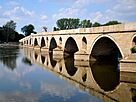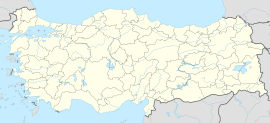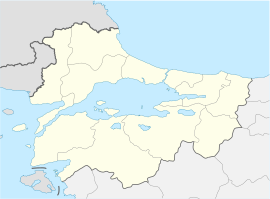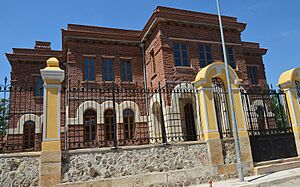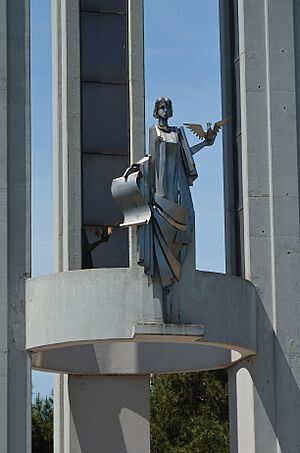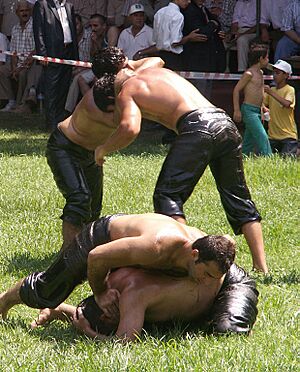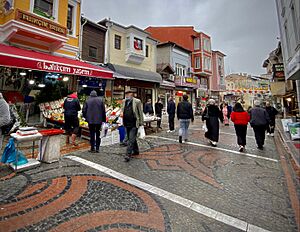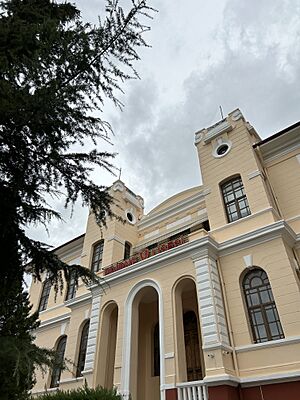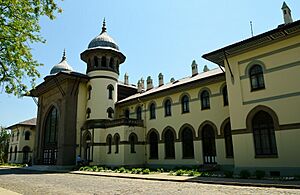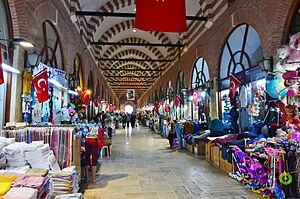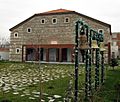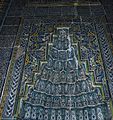Edirne facts for kids
Quick facts for kids
Edirne
|
||
|---|---|---|
|
From top down, left to right: Selimiye Mosque, Meriç Bridge, Old Mosque, Trakya University (formerly Karaağaç railway station), Üç Şerefeli Mosque, Grand Synagogue of Edirne, Town Hall, Historical Express
|
||
|
||
| Country | Turkey | |
| Province | Edirne | |
| District | Edirne | |
| Elevation | 42 m (138 ft) | |
| Population
(2022)
|
180,002 | |
| Time zone | TRT (UTC+3) | |
| Postal code |
22000
|
|
| Area code | 0284 | |
Edirne is a city in Turkey. It is located in the northwestern part of the Edirne Province. The city is very close to the borders of Greece (7 km away) and Bulgaria (20 km away).
Edirne was once the second capital city of the Ottoman Empire. This was from 1369 to 1453. After that, Constantinople (now Istanbul) became the capital.
Today, Edirne is a busy place for trade. It is known for woven fabrics, silks, carpets, and farm products. Tourism is also growing here. The city is home to about 180,000 people (as of 2022).
Edirne is famous in Turkey for its special dish called Edirne Fried Liver. This is liver that is breaded and deep-fried. It is often served with cacık, a cool dish made from yogurt and cucumber.
In March 2024, a new mayor was chosen for Edirne. Her name is Filiz Gencan Akın. She is a lawyer and took over from Recep Gürkan, who had been mayor for 10 years.
Contents
What's in a Name?
The city was first built by the Roman Emperor Hadrian. He named it Hadrianopolis. This name later became Adrianople in English. Before that, it was a Greek city called Orestias. Even earlier, it was a Thracian settlement named Uskudama.
The Ottoman name Edirne comes from the Greek name. The name Adrianople was used in English until 1928. Then, Edirne became the official name around the world.
A Look Back in Time: Edirne's History
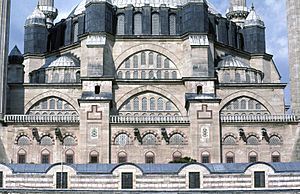
The area around Edirne has seen many big battles and sieges. This has happened since the time of the Roman Empire. Because it is on the border between Asia and Europe, Edirne has often been a place of conflict.
Ancient Times
The Roman Emperor Hadrian rebuilt the city. He named it Hadrianopolis. This was on the site of an older Greek city called Orestias. Before that, it was a Thracian settlement.
Important battles happened here. In 324, Licinius was defeated by Constantine I. In 378, Emperor Valens was killed by the Goths in a famous battle.
Medieval and Early Ottoman Rule
In 813, the city was taken for a short time by Khan Krum of Bulgaria. He moved its people to Bulgarian lands.
Later, in 1205, the Crusaders were defeated by the Bulgarian Emperor Kaloyan. This happened at the Battle of Adrianople.
In 1362, the Ottomans arrived. Sultan Murad I captured Adrianople. This was likely in 1369. The city became known as "Edirne" in Turkish. Murad I made it the new Ottoman capital. He moved it from Bursa.
Mehmed the Conqueror (Sultan Mehmed II) was born in Adrianople. The city stayed the Ottoman capital until 1453. That year, Mehmed II captured Constantinople (now Istanbul). He then moved the capital there.
Edirne was very important to the early Ottomans. This is why many old Ottoman mosques and schools (medreses) are still here. The Eski Sarayı (Old Palace) was mostly destroyed. Only small parts of it remain.
The Uzunköprü Bridge is the world's longest medieval stone bridge. It connects Anatolia with the Balkans. It was built between 1426 and 1443.
Later Ottoman Period
Edirne remained special to the Ottomans. Sultan Mehmed IV even left Topkapı Palace in Constantinople to live and die here in 1693.
Lady Mary Wortley Montagu, the wife of the British ambassador, visited Edirne in 1717. She wrote about her time there. She saw Sultan Ahmed III go to the mosque. She also visited the Selimiye Mosque.
Adrianople was a key fortress. It protected Constantinople during the Balkan Wars of 1912–13. The Bulgarians briefly took it in 1913. This was after a long siege.
The Great Powers (Britain, Italy, France, and Russia) tried to make the Ottoman Empire give Edirne to Bulgaria. But the Ottomans never officially gave up the city.
Edirne was quickly taken back by the Ottomans. This happened during the Second Balkan War. Enver Pasha led this effort.
During the Greek War of Independence, the Russo-Turkish War (1877–1878), and the Balkan Wars, many Balkan Muslims moved to Edirne. They were called Muhacir.
Turkish Republic
Edirne was given to Greece by the Treaty of Sèvres in 1920. But it was taken back by Turkey in 1922. This happened after the Greco-Turkish War (1919–22). Under Greek rule, Edirne was called Adrianople. It was the capital of the Adrianople Prefecture.
Religious Buildings
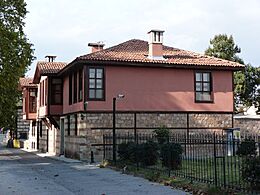
Edirne has been home to many different religious groups. It was the center for Greek and Armenian bishops. There were also some Protestants.
In 2018, archaeologists found parts of an old Byzantine church. This church was built around 500 AD. It was an early Byzantine building.
Edirne's Weather
Edirne has hot, somewhat dry summers. Its winters are chilly, wet, and often snowy.
The highest temperature ever recorded was 44.1°C (111.4°F) on July 25, 2007. The lowest temperature ever recorded was -19.5°C (-3.1°F) on January 14, 1954.
| Climate data for Edirne (1991–2020, extremes 1930–2023) | |||||||||||||
|---|---|---|---|---|---|---|---|---|---|---|---|---|---|
| Month | Jan | Feb | Mar | Apr | May | Jun | Jul | Aug | Sep | Oct | Nov | Dec | Year |
| Record high °C (°F) | 20.5 (68.9) |
24.5 (76.1) |
28.0 (82.4) |
33.5 (92.3) |
37.1 (98.8) |
42.6 (108.7) |
44.1 (111.4) |
41.9 (107.4) |
39.9 (103.8) |
35.8 (96.4) |
28.0 (82.4) |
22.9 (73.2) |
44.1 (111.4) |
| Mean daily maximum °C (°F) | 7.1 (44.8) |
10.2 (50.4) |
14.3 (57.7) |
19.8 (67.6) |
25.5 (77.9) |
30.1 (86.2) |
32.7 (90.9) |
33.1 (91.6) |
27.9 (82.2) |
21.0 (69.8) |
14.4 (57.9) |
8.4 (47.1) |
20.4 (68.7) |
| Daily mean °C (°F) | 2.8 (37.0) |
4.8 (40.6) |
8.3 (46.9) |
13.2 (55.8) |
18.5 (65.3) |
22.9 (73.2) |
25.3 (77.5) |
25.4 (77.7) |
20.6 (69.1) |
14.8 (58.6) |
9.3 (48.7) |
4.4 (39.9) |
14.2 (57.6) |
| Mean daily minimum °C (°F) | −0.4 (31.3) |
0.7 (33.3) |
3.5 (38.3) |
7.3 (45.1) |
12.1 (53.8) |
16.1 (61.0) |
18.2 (64.8) |
18.3 (64.9) |
14.2 (57.6) |
9.9 (49.8) |
5.4 (41.7) |
1.2 (34.2) |
8.9 (48.0) |
| Record low °C (°F) | −19.5 (−3.1) |
−19.0 (−2.2) |
−12.0 (10.4) |
−4.1 (24.6) |
0.7 (33.3) |
6.0 (42.8) |
8.0 (46.4) |
8.9 (48.0) |
0.2 (32.4) |
−3.7 (25.3) |
−9.4 (15.1) |
−14.9 (5.2) |
−19.5 (−3.1) |
| Average precipitation mm (inches) | 65.8 (2.59) |
53.3 (2.10) |
52.8 (2.08) |
44.0 (1.73) |
57.5 (2.26) |
46.0 (1.81) |
39.6 (1.56) |
24.0 (0.94) |
39.2 (1.54) |
66.1 (2.60) |
66.4 (2.61) |
70.5 (2.78) |
625.2 (24.61) |
| Average precipitation days | 12 | 8.6 | 10.33 | 9.93 | 9.83 | 8.33 | 5.37 | 3.7 | 5.43 | 7.9 | 9.8 | 12.73 | 104 |
| Average snowy days | 4.6 | 3.5 | 1.8 | 0.1 | 0 | 0 | 0 | 0 | 0 | 0.2 | 0.5 | 3.2 | 13.9 |
| Average relative humidity (%) | 82.6 | 76.9 | 72.7 | 67.5 | 65.2 | 62.1 | 56.9 | 56.2 | 62.8 | 74.6 | 80.2 | 82.5 | 70.0 |
| Mean monthly sunshine hours | 68.2 | 98.9 | 130.2 | 171.0 | 229.4 | 255.0 | 288.3 | 279.0 | 198.0 | 136.4 | 87.0 | 58.9 | 2,000.3 |
| Mean daily sunshine hours | 2.2 | 3.5 | 4.2 | 5.7 | 7.4 | 8.5 | 9.3 | 9.0 | 6.6 | 4.4 | 2.9 | 1.9 | 5.5 |
| Source 1: Turkish State Meteorological Service | |||||||||||||
| Source 2: NOAA(humidity), Meteomanz(snowy days 2000-2023) | |||||||||||||
Cool Places to Visit
Edirne is famous for its many mosques and other Ottoman buildings.
Amazing Mosques
The Selimiye Mosque was built in 1575. It was designed by Mimar Sinan, Turkey's greatest architect. This mosque is the most important building in Edirne. It became a UNESCO World Heritage site in 2011.
Its minarets (tall towers) used to be the highest in Turkey. They are 70.90 meters (232.6 feet) tall. The mosque was named after Sultan Selim II. It is decorated with beautiful Turkish marble and İznik tiles. It is part of a large group of buildings.
The Eski Cami (Old Mosque) started being built in 1403. It was finished in 1422. The Üç Şerefeli Mosque (Three-Balconied Mosque) is even more beautiful. It was built between 1437 and 1447 for Sultan Murad II. It was the biggest mosque built in the Ottoman lands before Constantinople was conquered. Both these mosques are in the center of Edirne.
Further from the center is the complex of Sultan Bayezid II. It was built between 1484 and 1488. This complex has a lovely, quiet location. It is the most complete mosque complex left in Edirne. It includes a soup kitchen, a hospital, and a medical school. Some parts of it are now a museum about Islamic medicine.
Edirne Palace
Edirne Palace was built during the time of Murad II. It was mostly destroyed in 1877 during a war. The palace gate and kitchen have been fixed. The Kasr-ı Adalet ("Justice Castle") is still standing. It was part of the palace complex. It is next to the small Fatih Bridge over the Tunca river.
Other Historic Religious Sites
The Grand Synagogue of Edirne was built in 1909. It was fixed up and reopened in March 2015. There is also a Roman Catholic church and two Bulgarian Orthodox churches in the city.
Other Historic Places
Edirne has three old covered markets called bazaars. The Kavaflar Arastası is next to the Selimiye Mosque. The Bedesten is next to the Eski Cami. The Semiz Ali Paşa Çarşısı (Ali Pasha Bazaar) was also designed by Mimar Sinan. It was built in 1568. At Kavaflar Arastası, you can find small handmade brooms with mirrors. You can also buy fruit-shaped soaps there.
Only small parts of the old Roman Hadrianopolis walls remain. They are near the "Macedonian Tower." This tower was probably part of the old defenses.
The Edirne Museum has collections of local history and culture. Outside, you can see an example of a dolmen. These are ancient stone structures.
In the city center are the Rüstem Pasha (1560–61) and Ekmekcioğlu Ahmed Pasha caravanserais. These were inns for travelers. The Rüstem Pasha Caravanserai is now the Kervansaray Hotel.
The Balkan Wars Memorial Cemetery in Edirne is near the Edirne Palace ruins. It has a monument to unknown soldiers.
The Meriç and Tunca rivers flow around the city. They are crossed by beautiful arched bridges. These bridges are from early Ottoman times.
The old Karaağaç railway station has been restored. It now houses Trakya University's Faculty of Fine Arts. The Treaty of Lausanne Monument and Museum are in the park nearby.
Fun Festivals
The Kırkpınar oil-wrestling tournament happens every year. It is held in late June or early July.
Kakava is an international festival. It is celebrated by the Romani people in Turkey. It takes place on May 5-6 each year.
Bocuk Gecesi is a festival from the Balkans. It is celebrated in mid-January. This is usually the coldest day of the year. It is a bit like a Turkish Halloween.
Edirne's Economy
Edirne's economy mostly relies on farming. About 73% of the people who work are in agriculture, fishing, or forestry. The flat lands around the city are very good for growing crops. Corn, sugar beets, and sunflowers are the main crops. Melons, watermelons, rice, tomatoes, and eggplants are also important. Growing grapes for wine is also done here.
A major highway connecting Europe to Istanbul and the Middle East goes through Edirne.
Industries are growing in Edirne. Businesses that use farm products are especially important for the city's economy.
Learning in Edirne
Universities
- Trakya University
High Schools
- 80th Year of Republic Anatolian High School
- Edirne Anatolian Teacher Training High School (now Edirne Social Sciences High School)
- Edirne Anatolian Technical High School
- Edirne Beykent High School of Science
- Edirne Beykent High School of Anatolian
- Edirne High School (Anatolian High School)
- Edirne Ilhami Ertem High School
- Edirne Industrial Vocational High School
- Edirne Milli Piyango Trade Profession High School
- Edirne Suleyman Demirel Science & Maths High School
- Edirne Yildirim Anatolian High School
- Edirne Fine Arts High School
Images for kids
Sister Cities
 Alexandroupolis, Greece
Alexandroupolis, Greece Ardahan, Turkey
Ardahan, Turkey Bat Yam, Israel
Bat Yam, Israel İzmit, Turkey
İzmit, Turkey Kars, Turkey
Kars, Turkey Lörrach, Germany
Lörrach, Germany Yambol, Bulgaria
Yambol, Bulgaria Gödöllő, Hungary
Gödöllő, Hungary Prizren, Kosovo, Serbia
Prizren, Kosovo, Serbia
Famous People from Edirne
Ottoman Sultans
- Bayezid I (1360—1403), an Ottoman sultan.
- Mahmud I (1696—1754), an Ottoman sultan.
- Mehmed the Conqueror (1432–1481), the Ottoman sultan who conquered Constantinople.
- Mustafa II (1664–1703), an Ottoman sultan.
- Osman III (1699—1757), an Ottoman sultan.
- Şahin Giray (1745-1787), the last khan of Crimea.
Other Historical Figures
- Athanasius I of Constantinople (1230—1310), a religious leader.
- Theodore Branas, a Byzantine general.
- Anthim the Iberian (1650-1716), a Georgian scholar and priest.
- Joseph Halévy (1827—1917), a Jewish-French scholar and traveler.
- Charles XII, the King of Sweden, who stayed here in 1713.
- Baháʼu'lláh, the founder of the Baháʼí faith, lived in Edirne from 1863 to 1868.
Modern Figures
- Cem Adrian (born 1980), a Turkish singer and songwriter.
- Acun Ilıcalı (born 1969), a Turkish TV personality and producer.
- Muharrem Korhan Yamaç (born 1972), a Paralympics champion in shooting.
See also
 In Spanish: Edirne para niños
In Spanish: Edirne para niños



